CLIMATEWIRE | EPA will release its most stringent power plant standards in history Thursday, but it won't be enough on its own to deliver President Joe Biden's near-future climate goals.
Biden has built his commitment to the Paris Agreement around a U.S. power grid that runs on 80 percent clean energy by 2030 — and that has net-zero emissions five years later. By contrast, EPA’s rule would achieve relatively light emissions reductions from power plants until 2030.
The draft rules EPA will unveil Thursday morning would require new and existing gas plants — excepting those that only run part time — to capture 90 percent of their emissions by 2035. Existing coal-fired power plants would need to hit that 90 percent target in 2030, but only if operators plan to keep them in operation in 2040.
The reductions EPA projects in the early years of the rule will be relatively modest. EPA's regulatory documents for the draft rule estimate that will result in a drop of 10 million metric tons of CO2 in 2028 compared with 2027. The U.S. power sector produced 1,539 million metric tons of carbon last year, according to the U.S. Energy Information Administration.
While the emissions curve would bend sharply down after 2030 — and particularly by 2035 — the rule never results in a zero-carbon grid, according to the EPA documents.
But on a call yesterday afternoon with reporters, EPA Administrator Michael Regan expressed confidence that “where we will end up will be squarely in line with the president's goal of 100 percent by 2035.”
White House climate adviser Ali Zaidi said on the same call that the president’s Paris pledge to halve emissions across the economy by 2030 would be achieved through the “totality of his climate and clean energy agenda.” That includes regulation, he said, but also newly enacted clean energy incentives and other policies.
EPA’s power plant proposal “reinforces our trajectory in a critical sector of the economy, in the power sector,” Zaidi said.
EPA projects the draft rules will avoid 600 million metric tons of carbon through 2042 — an amount equivalent to taking half of U.S. cars off the road for one year. EPA will accept public comment on the rule for 60 days after it is published. The draft also formally rolls back a weaker Trump-era power plant carbon standard.
EPA’s proposal covers three power plant categories: new and existing gas plants and existing coal-fired power plants. Newly built coal has been regulated since 2015, and EPA stated in a fact sheet that it decided not to revise that standard because “we anticipate no further new units.”
The draft rules offer utilities years of lead time to build out carbon capture or hydrogen infrastructure — or to take their plants offline.
Retirements vs. retrofits
Regan acknowledged on the call that EPA expects the rule to drive some coal plant retirements, though he stressed that would be left up to utilities and states. But the proposal’s modest requirements for coal plants that are retiring, and for rarely used gas facilities, could influence those business decisions.
Coal plants that commit to retire by 2032 or to run at a maximum 20 percent capacity ahead of a 2035 retirement date would be required to do only “routine maintenance.” Coal plants that don’t meet those criteria but are slated for retirement in 2040 would burn 40 percent gas — or find an alternative way to make comparable reductions. Gas plants that run at a maximum of 20 percent capacity are required only to burn lower-emitting fuels.
The toughest targets apply to so-called baseload gas and to coal that is intended to run for the long haul. Gas plants are offered an alternate compliance route that phases in co-firing with low-carbon hydrogen in 2032 and ramps it up to a 96 percent hydrogen blend by 2038.
A senior EPA official on the same call said the agency aims to avoid requiring retrofits for plants that are nearing the end of their useful life and might not recover the investment. Another official said that subsequent implementation plans would ensure that utilities live up to their retirement commitments.
A substantial share of the rules’ reductions likely will ultimately come from retirements rather than retrofits.
Rich Nolan, president and CEO of the National Mining Association, which represents the coal industry, said coal plant retirements seemed to be EPA’s objective — and that, he argued, would prove to be a legal vulnerability.
“There are certainly coal-fired power plants that have a long useful life left, and if the playing scale were level, they wouldn't make those investments,” he said, referring to CCS. “It's very difficult to justify spending the amount of money on a compliance technology that's greater in value than the plant itself.”
But Regan said the overall cost of the draft rules would be “negligible.” EPA has projected up to $85 billion in benefits from avoided climate change and health impacts.
EPA officials also pointed to last year’s expansion of a lucrative tax credit for carbon capture from $50 per ton of CO2 to $85 per ton, which they said would offset the full cost of CCS retrofits at some plants.
States and utilities will have the option of meeting EPA’s eventual standard through alternative means. That may include building out renewable energy instead of CCS or hydrogen.
“It could be that in the near term with upgrades, gas and coal could stay viable,” said Jim Murphy, director of legal advocacy at the National Wildlife Federation. “But is that investment going to pay off long term as renewables become cheaper and cheaper?”
“Complying with this rule could make a plant [that utilities] know is going to be obsolete in 30 years — it could make it obsolete in five or 10,” he said.
This story also appears in Energywire.
Reprinted from E&E News with permission from POLITICO, LLC. Copyright 2023. E&E News provides essential news for energy and environment professionals.


